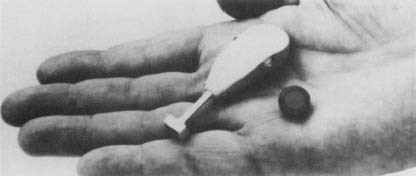Hearing Aids and Implants
Hearing aids are electronic devices that amplify sound for people with impaired (damaged) hearing. Millions of hearing aids are sold annually. Hearing aids are similar to a public address system, but in miniature. They consist of a microphone, amplifier, receiver, and battery.
Two Types of Devices
Two types of hearing aids are available: those that conduct sound through the air and those that conduct sound through bone. Most people who are hearing impaired can use an air-conduction hearing aid. This type amplifies sound and transports it directly into the ear via a small tube.
For people who have a problem hearing sound waves transmitted through the inner or middle ear, however, the bone-conduction hearing aid is recommended. This type of hearing aid uses a small vibrator clamped to the bony part of the head behind the ear. The bone transmits the sound waves to the nerves of the ear.
A Typical Hearing Aid
A typical hearing aid contains a microphone, which picks up sounds and converts them into electric signals. The hearing aid's amplifier increases the strength of the electric signals, and then the receiver converts the signals back into sound waves that can be heard by the wearer. The entire mechanism is housed in an earmold that fits snugly in the ear canal. A small battery provides the power to run the electronic parts.
Hearing aids are manufactured in a variety of designs to fit the need of the wearer. Some are small enough to be completely concealed by the ear canal, yet powerful enough to adjust to the desired level of amplification.
Hearing Aids in History
Devices to aid hearing have a long history. The idea of bone conduction was known in the early seventeenth century, and the ear trumpet was used even before that time. The ear trumpet was shaped to gather sound and funnel it into the ear. In seventeenth-century Germany, Marcus Banzer used a piece of swine bladder connected to a tube made of elk hoof to make an artificial ear drum. Later in that century the audiphone, or

Perhaps the largest hearing aid ever made was an imposing throne built for King John VI of Portugal in 1819. The hollow carved arms of the chair terminated with the wooden mouths of lions through which people would speak and have their voices carried by tubes to the king's ear.
Yet another artificial ear drum was devised in 1852 when the English physician Joseph Toynbee used a disk of vulcanized rubber attached to a rod. The Victorian era was known for some of its more elaborately concealed hearing devices, hidden in urns, top hats, even tiaras.
In the 1870s, Alexander Graham Bell (1847-1922) began experimenting with the conduction of sound through electrical devices, originally intending to help deaf children hear. His experiments led to the invention of the telephone instead, but his work did bring public awareness to the needs of the hearing impaired. Miller Reese Hutchinson invented the first electrical hearing aid in 1901, and he called it the Telephone-Transmitter.
The era of vacuum tubes like those used in early radio saw the inroduction of new types of hearing aids, starting in 1920 with Earl Charles Hanson's Vactuphone. A 1923 model produced by the Marconi Company was the Otophone, consisting of an amplifier placed in a large case weighing 16 pounds (7 kg), making it rather bulky to use. A. Edwin Steven invented the first "wearable" hearing aid, weighing 2.5 pounds (1.1 kg), in 1935. During the 1950s, transistors revolutionized electronics, and Microtone introduced its compact and powerful transistor hearing aid in 1953.
Implants
People who are profoundly hearing impaired and cannot successfully use a hearing aid sometimes can have an implant to improve hearing. The first cochlear implants were done in 1973. In this procedure, an electric device that stimulates the remaining functional nerves in the inner ear are implanted into people with nerve deafness. Although the implant does not restore normal hearing, it does help the recipient hear and interpret environmental sound. Today, more sophisticated multichannel electrical cochlear implants that contain speech processors allow some patients to understand speech without reading lips.
Robert V. Shannon of the House Ear Institute of Los Angeles has developed an auditory brainstem implant for people in which the auditory nerve has been severed. The implant consists of a tiny microphone, a sound processor, and a transmitter that are all outside the ear and an electrode that is implanted inside the head, connected to the auditory brain stem. When the microphone picks up sound, the unit converts sound energy into electric signals that are sent directly to the brain, where they are interpreted as sound. Although the implant is not enough to restore hearing, it upgrades the level of environmental sound heard by the user, and at least one implant volunteer has been able to understand limited human speech.
Comment about this article, ask questions, or add new information about this topic: